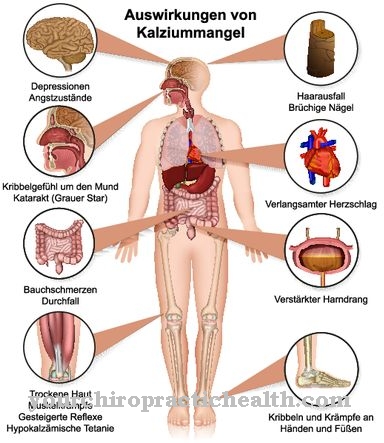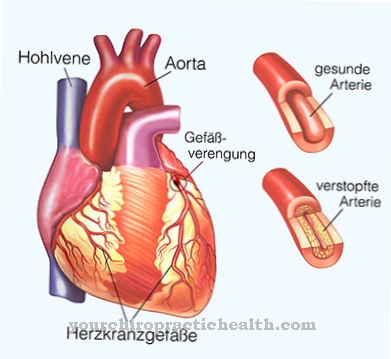As diabetic ketoacidosis is called a failure of the metabolism. Type 1 diabetics are affected here. Diabetic ketoacidosis occurs suddenly and can be fatal. Diabetic ketoacidosis is caused by an excessively high blood sugar level and a pronounced insulin deficiency.
What is Diabetic Ketoacidosis?

© designua - stock.adobe.com
Diabetic ketoacidosis is a metabolic disorder. Insulin-dependent (type 1) diabetics are particularly affected. Diabetic ketoacidosis can occur when blood sugar levels are not well controlled.
However, metabolic failure can also occur suddenly. A lack of insulin causes blood sugar levels to rise sharply. This condition is also known as hyperglycemia. Due to excessive thirst and constant urination, the body loses fluids and slowly dries up (desiccation).
In addition to cardiovascular and kidney problems, there are disorders of consciousness which, if left untreated, can lead to a coma. Diabetic ketoacidosis must be treated immediately in the hospital, as it can lead to death if left untreated or inadequately treated.
causes
Diabetic ketoacidosis can be triggered by several factors. One of the causes is often undetected diabetes mellitus. Another cause is an incorrectly set blood sugar value. Insulin-dependent diabetics inject too little insulin or only take tablets.
Depending on the severity of the diabetes, insulin can be supplied via a so-called insulin pump. It can happen that the inserted catheter is blocked so that no more insulin can be administered.
Illnesses, infections or operations can also trigger diabetic ketoacidosis, as there is often an increased need for insulin. Alcohol can also be a trigger. Furthermore, there are hereditary diseases in which there is a congenital deficiency in succinyl-CoA acetoacetate transferase, which cause the metabolic disorder.
However, all of these factors have one thing in common: insulin deficiency. The body needs insulin so that the individual cells can absorb sugar. If there is a lack of insulin, sugar can only be absorbed to a limited extent. The result is that the sugar builds up in the blood and the blood sugar level rises dramatically.
Since the cells still need energy, so-called ketone bodies (ketones) are formed in the liver, which cause the blood to become excessively acidic. The excess of sugar and ketones deprive the body of water and electrolytes, which are excreted in the urine, which can lead to dehydration, Kussmaul breathing, cardiovascular disorders, impaired consciousness, coma and death.
Symptoms, ailments & signs
Diabetic ketoacidosis is characterized by over-acidification of the blood as part of diabetes. The blood sugar levels are greatly increased. The patient suffers from severe thirst, polyuria, drowsiness, physical weakness and vomiting, among other things. The high water loss leads to dehydration of the body.
The dehydration or desiccosis is characterized by persistent folds of skin on the back of the hand, weight loss, cramps, anuria, constipation and thickening of the blood. As a result, disorders of consciousness up to a diabetic coma occur. A typical sign is the so-called Kussmaul breathing.
It is a very deep and regular breathing, which should prevent a further drop in the pH value, i.e. further acidification of the blood. Since the glucose can no longer be used due to the insulin deficiency, increased fat burning occurs. This creates ketone bodies, which lead to over-acidification of the blood. Typical is an intense odor of acetone in the breath, which is also one of the ketone bodies.
It is a fruity, putrid, or sweet smell. Without treatment, diabetic ketoacidosis is fatal. The decisive factor for the severity of the disease is not the level of blood sugar, but the extent of dehydration and the pH value. Therefore, with this complication, in addition to treatment with insulin, only an intravenous infusion of large amounts of fluid can save lives.
Diagnosis & course
If diabetic ketoacidosis is suspected, the emergency services must be called immediately or the person affected must be taken to hospital immediately.
Diabetic ketoacidosis is diagnosed by the doctor. The blood sugar level is determined at the beginning. In addition, the sugar and the ketone bodies in the urine are determined. In addition, the pH value of the blood is measured, the sodium and potassium values and the blood gases are determined. Diabetic ketoacidosis can also be recognized by the breath of the person affected, as it smells strongly of acetone (similar to the smell of the nail polish remover).
The course of diabetic ketoacidosis can be fatal. The patient will only recover if the symptoms are recognized in good time and treatment can be initiated immediately. Inadequately treated, permanent damage to the kidneys, heart, brain, etc. can occur. Since the circulatory system fails very quickly in diabetic ketoacidosis, many sufferers fall into a coma, from which most of them only partially recover.
Complications
Diabetic ketoacidosis is a serious complication of diabetes mellitus. In order to avoid further consequential damage, it should be treated as soon as possible. Possible complications arise on the one hand from the symptoms of ketoacidosis.
Confusion and visual disturbances can lead to further dangers such as falls and broken bones. Care should be taken in normalizing blood sugar levels. If the regular blood sugar is adjusted too quickly, there is a risk of brain edema. As a result, different complications can arise. A visual disturbance up to a complete loss of vision is possible.
Memory loss, fainting, and seizures are other risks. If the intracranial pressure increases too much as a result of the edema, areas in the brain can be damaged. In the worst case, the damage is irreversible. The respective consequences depend on the affected area of the brain. Another possible complication is potassium deficiency. This can then lead to cardiac arrhythmias.
In summary, it should be emphasized that ketoacidosis must be treated as quickly as possible. With correct and quick therapy, the likelihood of further complications occurring is very low. However, if not properly treated, there is a risk of falling into a diabetic coma. In a few cases, ketoacidosis can therefore be fatal.
When should you go to the doctor?
If diabetic ketoacidosis is suspected, the emergency services must be called immediately or the person affected must be taken to the nearest clinic immediately. So anyone who notices excessive thirst, frequent urination and other warning signs should have these clarified quickly. If symptoms such as impaired consciousness or severe abdominal pain occur, the emergency medical service is the right contact. If there are serious cardiovascular complaints or even a diabetic coma, the emergency doctor must be alerted.
Diabetic ketoacidosis is often triggered by undiagnosed diabetes mellitus. An incorrectly set blood sugar value and various diseases, infections or operations can also lead to metabolic failure. Anyone who suspects that one of these factors might be present should see a doctor immediately.
If there is a specific suspicion, it is best to consult the hospital directly. After the initial treatment, the cardiologist, diabetologist, neurologist or podiatrist should be consulted, always depending on the symptoms that arise. Going to a psychologist may also make sense.
Doctors & therapists in your area
Treatment & Therapy
Treatment of diabetic ketoacidosis must always be done in the hospital. In cases with severe symptoms, intensive monitoring is usually necessary.
The first step in treatment involves lowering blood sugar levels. Here, insulin is brought directly into the veins by means of injections and infusions. In addition to lowering blood sugar levels, it is important to stop the acidification of the blood. If the ketone body value is greatly increased and the acidification of the blood by the injected insulin does not decrease, bicarbonate is also administered if necessary.
Together with the first part of the treatment, fluids are administered so that the loss of fluids is compensated for. Dehydration causes the body to lose valuable minerals such as B. Sodium and Potassium. The loss of electrolytes is compensated for by means of infusions, so that the circulation stabilizes as a result of the increased fluid intake.
If diabetic ketoacidosis was caused by an illness or infection, these are targeted with drugs - u. a. high-dose antibiotics - treated.
Outlook & forecast
Immediate emergency medical treatment is crucial for the course of diabetic ketoacidosis. Without treatment, this condition usually leads to death quickly. Death occurs mainly from the very severe loss of fluid that results from severe polyuria.
However, if treatment is started immediately, there is a very good prospect of rapid improvement in symptoms. To overcome the dehydration of the body, fluids must be given immediately. In addition, an immediate infusion of insulin is necessary to normalize the high blood sugar level.
The rapid emergency measures can treat the acidification of the blood and the desiccosis well, but a cure is not possible because the diabetic ketoacidosis is based on diabetes mellitus with an absolute insulin deficiency. Incurable here means that without constant treatment, diabetic ketoacidosis would occur again and again.
An absolute insulin deficiency often occurs in the context of severe forms of diabetes mellitus. In most cases, it is type I diabetes mellitus. In this disease, the patient is constantly dependent on insulin to avoid diabetic ketoacidosis.
Health problems no longer arise under these conditions. After successful treatment of diabetic ketoacidosis, there are usually no sequelae. As part of the therapy, however, care should be taken to control the blood sugar level properly.
prevention
The following measures can be taken to prevent diabetic ketoacidosis. The most important point is a good blood sugar level adjustment. Furthermore, type 1 diabetics should always have an emergency dose of insulin with them.
The blood sugar level must be checked regularly. If there is an infection, diabetics should - after consulting their doctor - increase the insulin dose. The same applies to operations as well as diseases such as B. gastrointestinal infections. Alcohol should be avoided. This is especially true for diabetics.
Another preventive measure is the so-called emergency management. It is important to train family, friends, relatives and acquaintances. Doctors, health insurance companies and associations offer courses that teach how diabetic ketoacidosis can be recognized and what immediate measures must be taken.
Aftercare
Regular follow-up examinations with a diabetologist are essential after ketoacidosis. In any case, the cause should be determined. The risk of further ketoacidosis may be increased. Therefore, greater attention should be paid to the correct amount of insulin and correct injection. In the case of serious illnesses, injuries or operations, the amount of insulin may need to be adjusted.
A check of the insulin pump can be useful, as a defective pump often contributes to the development of excess blood acidity. Special blue sugar measuring devices with ketone test strips, with which a subsequent ketoacidosis can be detected at an early stage, are also helpful. Prescribed medication may have to be taken even after blood sugar has returned to normal, as otherwise there is a high risk of renewed ketone acidification.
It is therefore important to follow the doctor's instructions exactly. People living with the patient should be made aware of the ketoacidosis and then work with the patient to develop an emergency plan for it to come back. To do this, it is important to identify the symptoms that occurred during the first ketoacidosis and to pay more attention to them. In addition, relatives should be informed about what to do during ketoacidosis so that they can respond in an emergency.
You can do that yourself
Diabetic ketoacidosis is usually caused by a lack of insulin in type 1 diabetes. The disease also occurs very rarely with type 2 diabetes. In any case, it is an acute, life-threatening emergency that requires immediate medical treatment. If symptoms appear suddenly that indicate ketoacidosis, a hospital must be visited as soon as possible so that insulin can be administered intravenously and the person concerned can receive intensive medical care if necessary.
Self-help measures can be helpful in these cases as accompanying therapy. Above all, the supply of electrolytes - especially potassium - is important to maintain or restore a normal heart rate and to ensure other organ functions and metabolic processes.
After successfully overcoming diabetic ketoacidosis, which in many cases also requires the administration of bicarbonate (hydrogen carbonate) to raise the pH value, it is advisable to identify the reason (s) that lead to the insulin deficiency in the blood and thus the glucose deficiency in the cells and ultimately led to overacidification of the blood. Sudden ketoacidosis can also be caused by urinary tract infections, an infection in the gastrointestinal tract or alcohol abuse.
If the reasons have been properly clarified, appropriate self-help and preventive measures can help prevent diabetic ketoacidosis from recurring. Above all, strict control and adjustment of the recommended blood sugar concentration is required as a self-help measure.




.jpg)
.jpg)





















